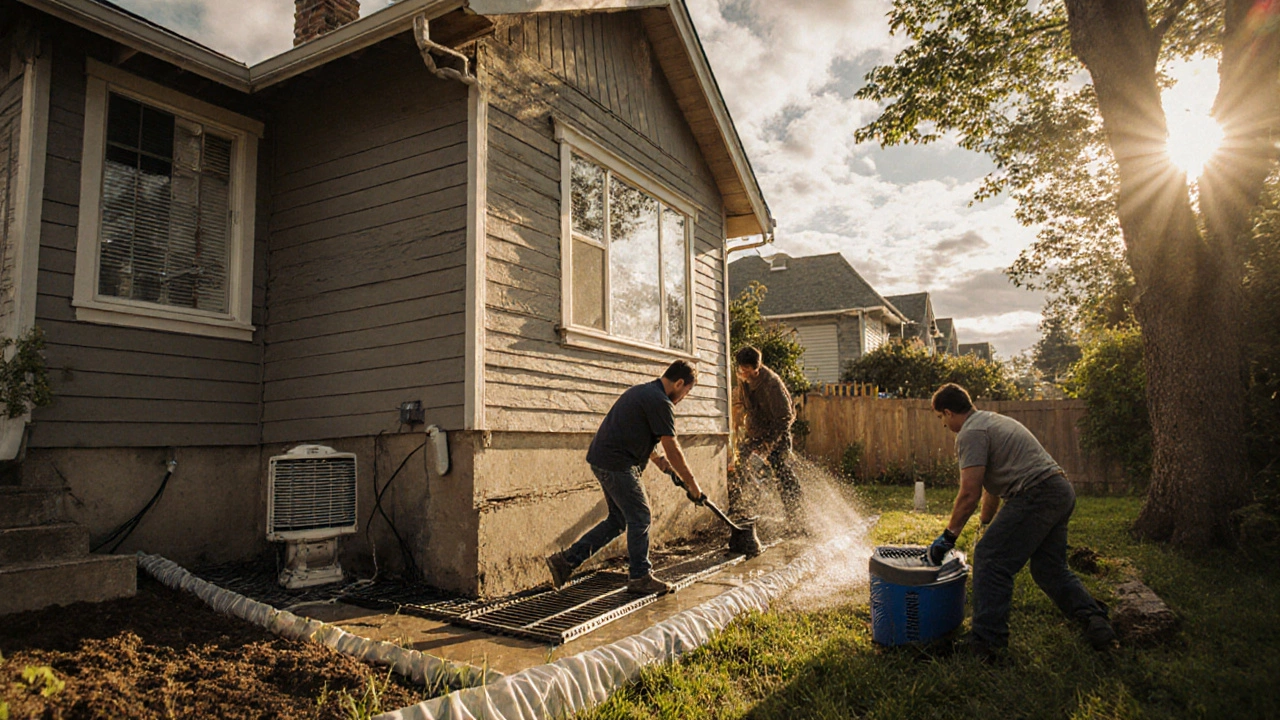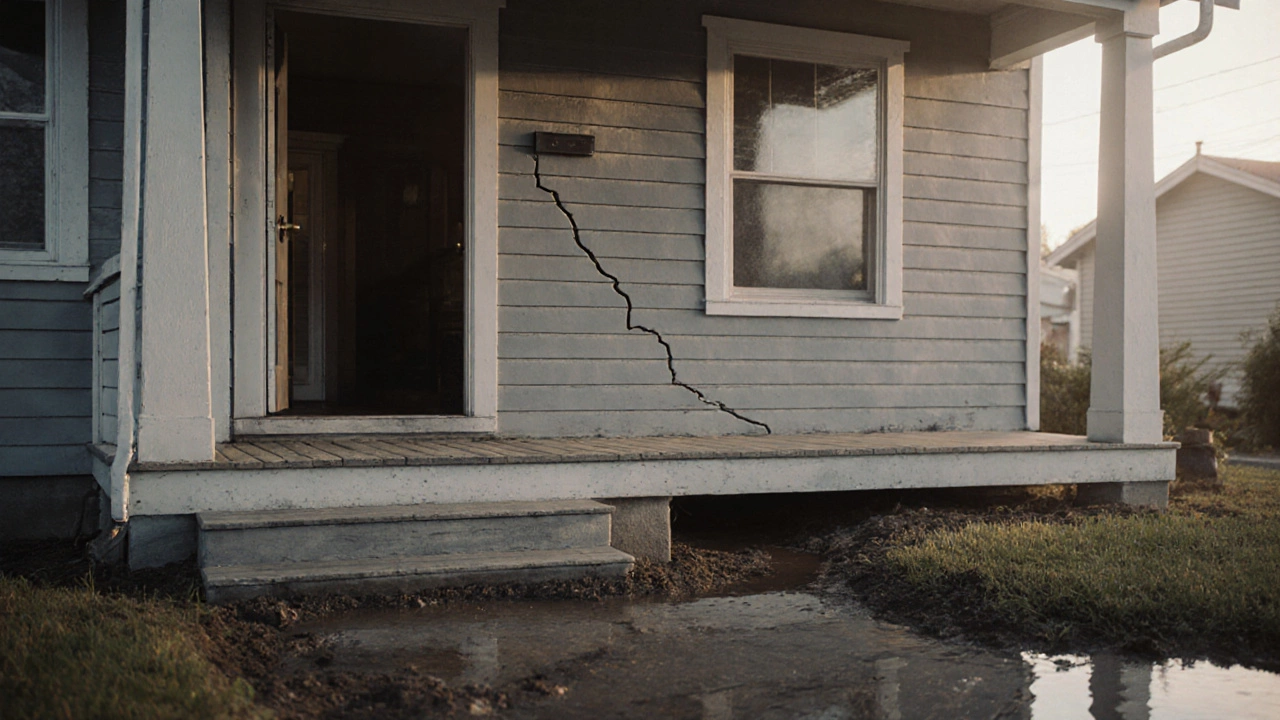Foundation Problem Diagnostic Tool
Home Foundation Assessment
This tool helps identify potential foundation issues based on the symptoms you observe. Enter your foundation type and select the symptoms you're experiencing to receive guidance on next steps.
Quick Takeaways
- Older homes are more likely to show foundation issues because of aging materials, historic building practices, and changing soil conditions.
- Typical red flags include cracked walls, doors that stick, and uneven floors.
- Three main foundation types-slab, crawl‑space, and pier‑and‑beam-each have distinct age‑related failure modes.
- A systematic visual inspection plus a professional level test can pinpoint problems early.
- Simple maintenance steps-drainage control, moisture management, and regular gap sealing-can extend a foundation’s life by decades.
Understanding Foundation Problems in Older Homes
When assessing an older house, Foundation problems are structural issues that affect the stability of a building’s base, often showing up as cracks, uneven floors, or doors that won’t close properly. These problems don’t magically appear; they are usually the result of long‑term stresses on the soil‑foundation interface, material fatigue, and environmental changes.
In Vancouver’s wet climate, for example, the combination of high groundwater and occasional seismic activity makes monitoring foundations even more critical. Knowing what to look for and why older homes are predisposed helps you decide whether a repair is needed or if preventive care will suffice.
Common Types of Foundations and Their Age‑Related Issues
Older homes were built using three primary foundation systems. Each system reacts differently to age, moisture, and load. The table below compares the three, highlighting typical problems that emerge after 30-50 years.
| Foundation Type | Typical Construction Era | Common Issues After Decades | Key Warning Signs |
|---|---|---|---|
| Slab foundation | 1950‑1990 | Soil settlement, shrink‑/swell‑soil movement, concrete cracking | Horizontal cracks in interior walls, doors that stick, uneven flooring |
| Crawl space foundation | 1930‑1960 | Moisture intrusion, wood rot in joists, vapor barrier failure | Musty smells, visible mold, sagging floorboards |
| Pier and beam foundation | Early 1900s‑1940s | Pier settlement, joist decay, differential movement | Cracked masonry, noticeable gaps under the house, doors that swing open |

How to Spot Early Warning Signs
Detecting foundation cracks before they widen can save thousands. Walk through the house and keep an eye on these specific cues:
- Horizontal or stair‑step cracks in basement walls-often a sign of soil settlement pressure. \n
- Doors and windows that jam or misalign, indicating floor movement.
- Visible gaps between the drywall and ceiling or floor joists.
- Uneven gaps around exterior trim or siding, especially after heavy rain.
- Water pooling near the foundation, which can create hydrostatic pressure against basement walls.
When any of these appear, note the exact location and size. Photographic documentation helps professionals diagnose the problem accurately.
Factors That Accelerate Foundation Damage in Older Homes
Even a well‑built foundation can deteriorate faster if certain external forces are present. Below are the most common accelerators:
- Changes in groundwater level: Vancouver’s rainy winters raise the water table, increasing pressure on below‑grade walls.
- Tree roots that grow beneath footings, pulling soil away and creating voids.
- Improper grading that directs surface runoff toward the house instead of away.
- Old or clogged sump pump systems that fail during a storm.
- Seismic events that shift the soil‑structure interface, especially for homes built before modern building codes.
Inspection Checklist for Homeowners
Before calling a contractor, run through this practical checklist. It costs time, not money, and often clarifies whether a full‑scale repair is needed.
- Exterior grading: Soil should slope away at least 6 inches within the first 10 feet.
- Drainage systems: Ensure downspouts extend at least 4 feet from the foundation.
- Basement walls: Look for horizontal cracks wider than 1/4 inch.
- Crawl space ventilation: Verify that vents are open and not blocked by insulation.
- Pier and beam support: Tap each pier; a hollow sound may indicate rot or settlement.
- Moisture measurement: Use a hygrometer; levels above 60 % in a crawl space are a red flag.
- Sump pump test: Pour a bucket of water into the pit and watch for activation within 30 seconds.
If any item raises concern, schedule a professional evaluation. A licensed structural engineer can perform a level‑back‑check (laser level) and soil bearing test to quantify movement.

When to Call a Professional & Cost Expectations
Minor cracks (< 1/8 inch) can often be repaired with epoxy injection, a job that usually runs $300‑$800. However, when you encounter any of the following, bring in a specialist:
- Horizontal cracks wider than 1/4 inch.
- Significant floor sagging (> ½ inch over a 10‑foot span).
- Recurrent water infiltration despite functional drainage.
- Visible movement in multiple rooms.
Repair methods vary:
| Repair Type | Description | Cost Range |
|---|---|---|
| Epoxy crack injection | Fills small cracks, restores structural continuity | $300‑$800 |
| Underpinning (push piers) | Stabilizes settling foundations by extending footings below frost line | $5,000‑$12,000 |
| Drainage overhaul | French drains, exterior waterproofing, grading correction | $3,000‑$9,000 |
| Solar‑powered sump pump upgrade | Ensures continuous removal of groundwater | $1,200‑$2,500 |
Getting multiple quotes and asking each contractor to explain their methodology helps avoid over‑selling.
Prevention & Maintenance Tips for Longevity
Even if your home is 70 years old, simple habits can keep the foundation healthy for another generation:
- Maintain consistent indoor humidity (45‑55 %). Use a dehumidifier in basements during summer.
- Inspect and replace damaged vapor barriers in crawl spaces every 5‑7 years.
- Trim tree roots away from footings; consider root barriers for large trees.
- Schedule an annual check of the sump pump and backup battery.
- After any major storm, walk the perimeter to ensure water is draining away, not pooling.
Following these steps reduces the stress on the soil‑foundation interface and makes any needed repairs less extensive.
Frequently Asked Questions
Do all old houses have foundation problems?
Not all, but the odds increase with age, especially if original construction used low‑grade materials or if drainage has been neglected over the years.
How can I tell if a crack is harmless?
Hair‑line, vertical cracks in plaster that don’t widen over time are usually cosmetic. Horizontal or stair‑step cracks larger than 1/8 inch warrant a professional opinion.
Is DIY repair ever safe?
For small, non‑structural cracks, epoxy kits are user‑friendly. Anything that affects load‑bearing elements-like piers, beams, or large slab shifts-should be left to licensed engineers.
What role does Vancouver’s climate play?
The city’s high precipitation raises groundwater levels, creating hydrostatic pressure that pushes against below‑grade walls. Proper waterproofing and drainage are therefore essential in this region.
How often should I have a professional inspection?
For homes over 30 years old, a thorough inspection every 3‑5 years is wise, or sooner after a major flood, earthquake, or noticeable new cracks.
By staying observant, keeping moisture under control, and knowing when to call in experts, you can protect an older home’s foundation and avoid costly, disruptive repairs. Remember, the best repair plan starts with an informed inspection.








